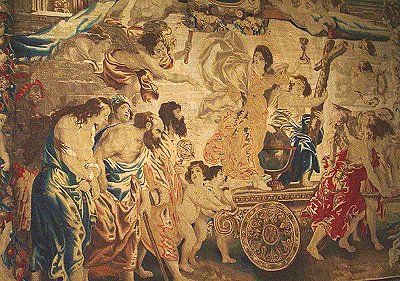Travels to Venice where he studied Titian, Veronese & Tintoretto freed his artistic talent from rigid classicism. While he did incorporate copies of classical statues in his paintings he always avoided the appearance and coldness of stone. To the contrary, his nudes, for which he became famous, always depicted an ample female form of vitality and good health as well as of sensuousness. His mastery of color along with his knowledge of antiquity is seen particularly in his mythological paintings. As court painter and confidant to the Archduchess Isabella Clara Eugenia, Rubens recognized the role art was to play in the Counter Reformation. His genius found expression in his designs for the Triumph of the Eucharist tapestries which he and his assistants completed between 1625 and 1628. Knighted by two monarchs and master of a successful workshop, Rubens became rich and famous in his own time. Having executed over 3,000 paintings, woodcuts and engravings of all types, he died the most respected artist of his time in 1640. Subject: Painting: Decorating the chariot with Faith is a globe representing the extent of her rule. In front of this globe is an angel holding a large wooden cross and two cherubs holding the instruments of the passion of Christ. The crown of thorns, loin cloth and the nails of the cross all refer to the sacrifice of Christ's life. One angel holding a torch and pointing the way illuminates the triumphal procession of Faith. Historical Context: The series is a mixture of allegory and religious propaganda intended to promote the worship of the Eucharist (ie the bread and wine consecrated as the body and blood of Christ and distributed at communion) which had been strengthened recently by the Council of Trent and which constituted an important element in Counter Reformation Catholicism. This was a time of great concern on the part of the Catholic church as it attempted to correct not only the abuses of the clergy but also to reaffirm its tenets / dogma in the face of attacks by the Protestant Reformation.
|
